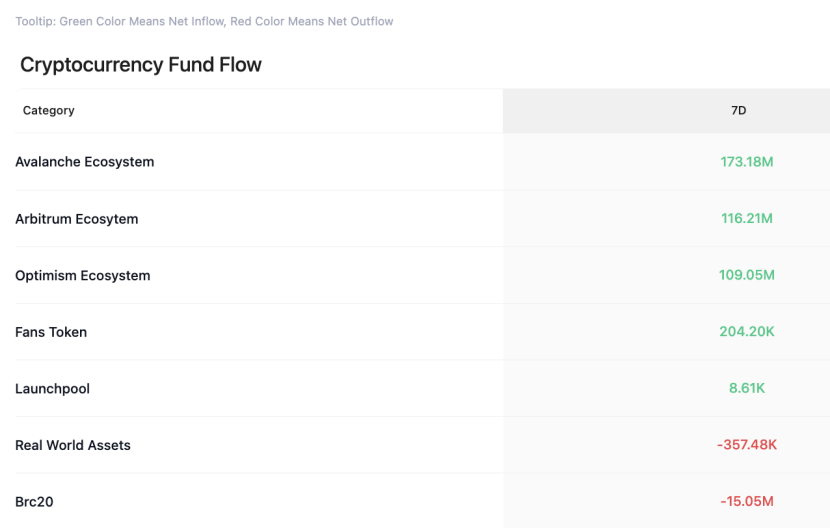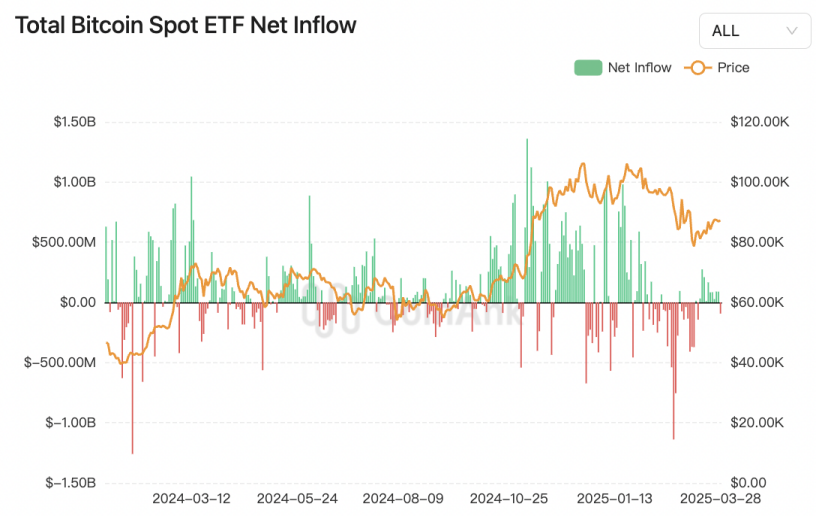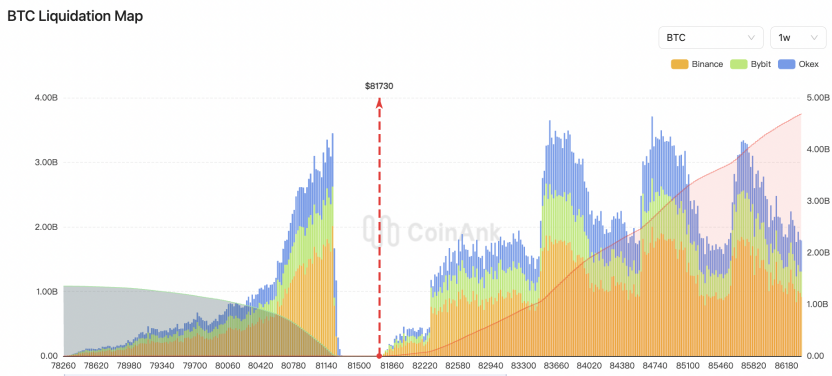This Week's Preview (3.17-3.23),BTC Liquidation Map Imbalance, Altcoin ETF Applications Covering 11 Types
Table of Contents:
Large Token Unlock Data for This Week;
Overview of the Crypto Market, Quick Read on Weekly Popular Tokens' Rise and Fall / Sector Fund Flow;
Spot ETF Fund Inflow and Outflow Situation;
BTC Liquidation Map Data;
Key Macroeconomic Events and Financial Data Forecast and Analysis for This Week.
1. Large Token Unlock Data for This Week;
From March 31 to April 6, 28 tokens will undergo a one-time unlock. The unlock value is sorted as follows:
Among them, OP, SOL, W, CHELL, and ENA have unlock values exceeding 20 million USD:
OP will unlock over 32.21 million tokens on March 31, with an unlock value of approximately 27.77 million USD, accounting for 0.75% of the circulating supply;
SOL will unlock over 2.72 million tokens on April 1, with an unlock value of 363 million USD, accounting for 0.54% of the circulating supply;
W will unlock over 1.367 billion tokens on April 3, with an unlock value of 130 million USD, accounting for 13.68% of the circulating supply;
CHELL will unlock over 2.67 million tokens on April 3, with an unlock value of 21.53 million USD, accounting for 0.27% of the circulating supply;
ENA will unlock over 134 million tokens on April 5, with an unlock value of 54.49 million USD, accounting for 0.9%.
Notably, SOL ranks first with an unlock value of 363 million USD, and its price has increased by 4.23% over the past 7 days.

The unlocking situation of these projects may have varying degrees of impact on the related markets. The above data is in UTC+8. This week, pay attention to the negative effects brought by the unlocking of these tokens, avoid spot trading, and seek shorting opportunities in contracts. The data is from CoinAnk.
We believe that the unlocking pressure on SOL is manageable, but market sentiment fluctuations should be monitored. Although the unlock amount for SOL is as high as 363 million USD, it only accounts for 0.54% of the circulating supply, which limits the actual impact on the market. Based on historical experience, institutional investors purchased SOL at an average price of 64 USD during the FTX bankruptcy auction, and the current price has significantly increased, but the motivation to sell may weaken due to long-term strategic positioning. Additionally, SOL's recent price trend is strong (up 4.23% in the past 7 days), reflecting market confidence in its ecological development, with staking mechanisms and on-chain activity providing price support.
W and CHELL have high unlocking ratios, posing significant short-term risks: W's unlock volume accounts for 13.68% of the circulating supply, far exceeding SOL and ENA (0.9%), and the surge in circulating supply may trigger short-term selling pressure. A similar event in July 2024 caused significant price fluctuations for W, necessitating caution regarding liquidity dilution risks. Although CHELL's unlock amount is relatively low, its circulating ratio (0.27%) is still higher than SOL's, and if demand support is lacking, there may be considerable price correction pressure.
The actual impact of token unlocking on the market depends on holder behavior. Historical data shows that institutional investors tend to hold high-growth potential tokens (like SOL) for the long term, while projects dominated by retail investors (like W) are more prone to short-term volatility risks. In the current market recovery context, investors should pay attention to changes in trading volume after unlocking and assess risks based on project fundamentals. SOL may be able to absorb selling pressure due to its ecological advantages, but tokens with high circulating ratios should be approached with caution.

2. Overview of the Crypto Market, Quick Read on Weekly Popular Tokens' Rise and Fall / Sector Fund Flow.
According to CoinAnk data, over the past 7 days, the crypto market, categorized by concept sectors, saw net inflows in five sectors: Avalanche Ecosystem, Arbitrum Ecosystem, Optimism Ecosystem, Fan Tokens, and Launchpool. In the past week, many tokens have also experienced rotational increases. The following are the top 500 by market capitalization, with tokens such as MLN, ZEC, FORM, REQ, CORE, and XAUT showing relatively high increases, and trading opportunities for strong tokens should continue to be prioritized.

3. Spot ETF Fund Inflow and Outflow Situation.
According to CoinAnk data, in the past week, the net inflow for the U.S. spot Bitcoin ETF was 196.4 million USD; the cumulative net outflow for the U.S. spot Ethereum ETF was 8.7 million USD.
With Nasdaq submitting a 19b-4 form application for the Grayscale Avalanche ETF, the current applications for altcoin ETFs submitted to the U.S. Securities and Exchange Commission cover 11 types, including: XRP, SOL, DOGE, ADA, AVAX, SUI, HBAR, DOT, LTC, APT, and AXL. It is reported that VanEck has also filed for the Avalanche ETF, and AVAX is currently ranked as the 15th largest digital asset by market capitalization.
We believe that the fund flow and product expansion trends of U.S. crypto ETFs reflect the risk repricing logic of institutional investors towards different categories of digital assets. The net inflow of 196.4 million USD for the Bitcoin spot ETF in a single week, contrasted with the net outflow of 8.7 million USD for the Ethereum ETF, reflects differences in regulatory attitudes— the SEC's consensus on BTC as a "non-security" enhances institutional confidence in allocation, while the review of the ETH staking mechanism remains unresolved, suppressing fund accumulation.
The expansion wave of altcoin ETFs reveals a deeper trend: the applications for 11 token ETFs covering assets like XRP, SOL, and AVAX essentially represent a passive adaptation of traditional finance to the diversification of narratives in the crypto market. Taking AVAX as an example, the competition between Grayscale and VanEck for the ETF is closely related to its modular subnet architecture attracting institutional-level applications (such as JPMorgan's Onyx settlement experiment), but its ranking as the 15th by market capitalization suggests that liquidity thresholds remain a key constraint. The current application list exhibits three characteristics: public chain infrastructure (DOT, APT), payment tokens (XRP, LTC), and meme assets (DOGE), reflecting institutions' attempts to capture beta returns in segmented tracks within the regulatory framework.
In terms of potential impacts, if altcoin ETFs are approved, it may trigger a liquidity siphoning effect, but two major risks should be noted: first, the SEC may exacerbate market volatility through a "phased release" strategy, such as only approving some ETFs, triggering fund migration; second, the imbalance between the market capitalization of underlying assets and the scale of ETFs may amplify price manipulation risks. In the short term, the return of funds to Bitcoin ETFs may signal the market entering a new phase of "core asset support - altcoin narrative rotation," but the space for regulatory arbitrage in the institutionalization process is narrowing.

4. BTC Liquidation Map Data.
CoinAnk liquidation map data shows that if BTC breaks through 88,660 USD, the cumulative short liquidation intensity on mainstream CEXs will reach 8.134 billion USD. Conversely, if Bitcoin falls below 78,260 USD, the cumulative long liquidation intensity on mainstream CEXs will reach 1.355 billion USD.
We believe that the asymmetric liquidation thresholds formed in the 78,260 to 88,660 USD range for Bitcoin reflect strategic layout differences between long and short forces at key price levels. Market elasticity is significantly differentiated: if it breaks through 88,660 USD, it will trigger 8.13 billion USD in short liquidations, six times the intensity of long liquidations, indicating that shorts are densely positioned near historical highs; while below 78,260 USD, the long liquidation volume is only 1.35 billion USD, reflecting relatively restrained long leverage, possibly due to institutional capital support.
The structural motivations include three logics: first, the CME Bitcoin futures open interest gap currently stands at 85,200 USD, resonating technically with the liquidation peak; second, short positions are concentrated above 89,000 USD, with some hedge funds attempting to bet on weak ETF fund flows (with a net outflow of 830 million last week) suppressing breakout momentum; third, on-chain data shows that whales have increased their holdings by 28,000 BTC in the 78,000-80,000 USD range, forming a liquidity moat.
In terms of potential transmission paths, breaking through 88,660 USD may trigger a short squeeze, pushing prices to test the psychological level of 95,000 USD, but caution should be exercised regarding the sudden rise in derivative funding rates (currently at 0.03%) that may lead to profit-taking. If it falls below 78,260 USD, long liquidations may combine with miner sell-offs (averaging 900 BTC daily), but 94% of ETF holders have a cost basis below 75,000 USD, which may limit the downside space. The current market is in a liquidity rebalancing phase of a bull market continuation, and directional choices need to be verified in coordination with macro liquidity and on-chain chip distribution.
5. Key Macroeconomic Events and Financial Data Forecast for This Week.
The important macro data to be released this week is as follows:
Monday 21:45, U.S. March Chicago PMI
Tuesday 21:45, U.S. March S&P Global Manufacturing PMI Final Value
Wednesday 20:15, U.S. March ADP Employment Change
Thursday 01:00, ECB President Lagarde's Speech
Thursday 19:30, ECB Releases March Monetary Policy Meeting Minutes
Thursday 19:30, U.S. March Challenger Job Cuts
Friday 00:00, Federal Reserve Vice Chair Jefferson's Speech
Friday 20:30, U.S. March Unemployment Rate, U.S. March Adjusted Non-Farm Payrolls, U.S. March Average Hourly Earnings Year-on-Year / Month-on-Month
Friday 23:25, Federal Reserve Chair Powell's Speech.
The intensive release of macroeconomic data and central bank officials' speeches in the U.S. and Europe this week will have a significant impact on the crypto market. The core focus includes:
Federal Reserve policy expectations dominate market sentiment. Federal Reserve Chair Powell's speech on Friday and statements from several officials will be the focus. If he emphasizes persistent inflation or delays interest rate cuts (as mentioned in hawkish tendencies), it may exacerbate risk asset sell-offs, putting pressure on cryptocurrencies like Bitcoin. Conversely, if he suggests a need for policy shifts due to economic slowdown, it may boost market liquidity expectations and drive a rebound in crypto assets. Additionally, the ADP employment data, as a precursor to non-farm payrolls, may reinforce expectations for maintaining high interest rates if it shows an overheated labor market, suppressing buying in the crypto market.
Non-farm data and PMI form cross-validation. The non-farm employment, unemployment rate, and wage growth data on Friday are particularly critical. If employment growth exceeds expectations (e.g., a forecast of +200,000) and wages rise month-on-month, it may confirm economic resilience, reducing the necessity for interest rate cuts, leading to a simultaneous pullback in the crypto market and U.S. stocks. Conversely, if the data is weak (e.g., indicating signs of employment slowdown), it will enhance expectations for easing, potentially boosting risk appetite and driving up crypto assets. At the same time, if the manufacturing PMI falls below the expansion line (as analyzed for contraction risks), it may raise concerns about economic recession, indirectly benefiting Bitcoin as "digital gold."
The spillover effects of the ECB's direction. If Lagarde's speech and the meeting minutes signal an early interest rate cut in the Eurozone, it may push up the dollar index through euro depreciation, exerting pressure on dollar-denominated cryptocurrencies. Conversely, if Europe maintains a tightening stance, a relatively weaker dollar may help attract funds into the crypto market.
In summary, the crypto market may exhibit high volatility this week, especially in short-term trading around data releases. The mid-term trend still depends on the interplay between the Federal Reserve's policy path and the possibility of a "soft landing" in the macro economy. If the data combination shows "strong employment + high inflation," Bitcoin may test key support levels; while a combination of "weak employment + low PMI" may catalyze market bets on liquidity easing, pushing crypto assets to break resistance. Historical experience indicates that subtle changes in Powell's wording often trigger significant price volatility, necessitating caution regarding immediate market movements following his speeches.
免责声明:本文章仅代表作者个人观点,不代表本平台的立场和观点。本文章仅供信息分享,不构成对任何人的任何投资建议。用户与作者之间的任何争议,与本平台无关。如网页中刊载的文章或图片涉及侵权,请提供相关的权利证明和身份证明发送邮件到support@aicoin.com,本平台相关工作人员将会进行核查。




